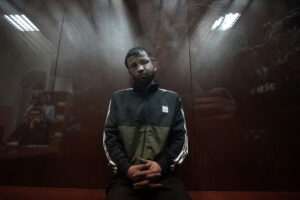To read a British newspaper or to listen to the rhetoric of counter-terrorism police, you could be forgiven for thinking that the country has incubated a new generation of child extremists. And not just any child extremists: unlike previous moral panics, the new face of terror isn’t a bolshie 15-year-old Muslim girl — but a pallid, autistic white boy.
A recent article in The Telegraph, warning of “the ‘perfect storm’ turning teenagers into terrorists”, is a case in point. The opening few paragraphs focus on Joe Metcalfe, a white neo-Nazi from Haworth, West Yorkshire, who had plotted to kill Muslims in an attack modelled on the Christchurch massacre in New Zealand in 2019.“The acne-afflicted teenager,” we are told, “is part of a growing phenomenon of teenage terror offenders in Britain, with 2023 seeing a new record of 42 under-18s arrested.” The report also singles out the case of another white teen, albeit one who converted to Islam and planned to attack non-Muslims at the Isle of Wight music festival in July 2022.
The subliminal message conveyed here is that indigenous British white boys are not all right, but rather are potentially far-Right— a message that news outlets have been pushing ad infinitum for the past few years. Drill down into the actual data on Britain’s convicted teen terrorists, however, and you will find a different and less politically convenient story. According to a report published last November by the International Centre for the Study of Radicalisation, between January 2016 and October 2023, 43 individuals in England and Wales were convicted of terrorism offences they committed as minors. The majority were far-Right (25), while 16 were jihadi and two had no clear or known ideological motivation. All except one — Safaa Boular, who was jailed for life for her role in an Isis-inspired plot to attack the British Museum — were male. The youngest was just 13. (The authors of the report, Hannah Rose and Gina Vale, have posted their dataset here.)
More striking, though, was the fact that none of the 43 had managed to commit an act of terrorist violence, none had procured a firearm and only one had come close to making a workable explosive device. Indeed, most were not, in fact, terrorists at all, but were instead the online fanboys of terrorism: they had downloaded, disseminated or created terrorist content on the internet — and a few had done a combination of all three. These are all offences under UK terrorism legislation and are punishable by up to 15 years’ imprisonment. One of the teens, a neo-Nazi from west London, had made a poster inciting violence against Prince Harry, calling him “race traitor” on account of his marriage to Meghan Markle. Another, a Muslim from Sutton Coldfield, had set up a “mujahdeen channel” on Telegram, where he gave a lesson on how to make a Molotov cocktail and offered advice on how to travel to Syria to join the jihad there.
The data cast an illuminating light on the ideology of the offenders, but you need to probe further to understand its implications. Of the 43 teenagers in Rose and Vale’s dataset, 13 — almost a third — were convicted of preparation of terrorist acts, which carries a maximum sentence of life imprisonment. And of those 13, seven had sought to join jihadi groups in war zones in the Middle East and North Africa, but were stopped by counter-terrorism police, while eight had unsuccessfully plotted to carry out terrorist acts in the UK. Among that last group, five were far-Right and three were jihadi.
Rose and Vale acknowledge that the “more serious” terrorism offences “were more common among Islamist individuals”, but they don’t enlarge on this point, although they make it clear that of the eight who plotted terrorist violence, the two who came closest to succeeding were jihadi-inspired. “While the extreme Right-wing teenage plotters outnumber Islamists in our dataset,” they write, “it is interesting to note that two planned large-scale Islamist attacks could meet the threshold of ‘late stage’ disruption after months of research and reconnaissance.”
It is also interesting to note that Rose and Vale’s dataset would look very different had they gone further back to the declaration of the Isis caliphate in mid-2014, giving them a decade-long perspective. That dataset would have included Shamima Begum and her two now deceased schoolmates, Kadiza Sultana and Amira Abase, and the other Bethnal Green schoolgirl who apparently inspired all three, Sharmeena Begum. It would have also included Talha Asmal, 17, who travelled from Dewsbury to Iraq to join Isis and in June 2015 carried out a suicide bombing there. And it would have included many other teenage boys who made the same dismal life-choices as Asmal. It would, in short, have produced an overwhelming statistical disproportion between jihadists and the far-Right and further cemented the impression that British teenagers who embrace jihad are far more dangerous than those who engage in far-Right terror fandoms in their bedrooms.
Another striking detail is that there are no incels among the 43 convicted teens. I point this out because while incel culture has reportedly “gone mainstream” in UK schools, no British schoolboy until now has been convicted of incel-related terrorism offences in this country. Given the enormous gaslighting around this issue of late, and the even bigger public and private digital-training-grift that parasitically engorges on it, the conspicuous absence of incels in the data is more than noteworthy.
A yet further striking detail is that of the 43 offenders, 13 had been referred at least once to Prevent, the UK’s counter-radicalisation programme, which, according to William Shawcross’s review last year, is excessively focused on Right-wing extremism, despite 80% of live police investigations involving Islamist plots. Prevent’s defenders insist that the scheme has stopped countless young people from engaging in extremism, but it’s impossible to empirically demonstrate this, given that we can’t know how their lives would have turned out had they not received support from Prevent. What we do know, however, is that a significant number who had received such support went on to commit terrorism offences. In one revealing section, Rose and Vale quote one of the teens as boasting: “I just had a two-hour conversation with a coconut mozlem which works with the government…He tried to ‘deradicalise’ me…They think we’re gunna stop following the haqq [truth] out of fear of them or of ignorance.”
Looking at the cold data, then, the overwhelming picture that emerges is not of dangerous masterminds, but of chaotic and cretinous loners immersed in an infantile online demi-monde of gore, murder fandom and sectarian hatred. Many grew up in troubled families and suffer from mental health problems, particularly autism. And while they were all vigorously invested in their ideological beliefs, their ability to competently act on them was, as Rose and Vale moderately put it, “less clear-cut”. Joe Metcalfe, for example, would have been a more serious proposition had he known how to drive: his plot came to a pitiful end when he stole his dad’s car and crashed it into a fence. Another far-Right plotter from Rugby was similarly ham-fisted, prompting the judge at his trial to describe his attack-planning as “inept”.
None of this means that teenage extremists are not a potential threat, and Rose and Vale are rightly determined to dispel the idea that they have no agency and were led astray by mysterious “online groomers”. The recent stabbing of an Assyrian bishop by a 16-year-old boy in Sydney testifies to this: he survived the attack, but his right eye didn’t.
The attack was revealing in other ways, too. Bishop Emmanuel has apparently forgiven his attacker, which is his right to do of course, while a spokesperson for the attacker’s family has relayed to the media that the teen had “anger management” problems and is a devout Muslim without being “fanatical”. Here we can see the inverse of today’s extremism panic, where the temptation is to pretend that it’s not happening at all, or that it’s only happening among those sketchy white kids.
The Head of the UK’s Counter Terrorism Policing, Matt Jukes, recently told a journalist that, when he first started his career in counter-terrorism 25 years ago, the dominant foes were organised groups such as al-Qaeda, whereas today the threat-picture looks very different: “One in five of the people we arrest [today] is a child… principally boys,” he said, adding that some were as young as 11 and that much of his work is now taken up with liaising less with MI5 and more with child and adolescent mental health services, schools and colleges.
Counter Terrorism Policing, in other words, has become an ancillary of Britain’s already over-bloated and ever-expanding therapeutic state. This is alarming for all sorts of reasons. Not only does it risk stigmatising the young people who come within its remit, but it also diverts resources away from investigating threats that are far more serious than that posed by acne-ridden teenagers in their bedrooms.
Disclaimer
Some of the posts we share are controversial and we do not necessarily agree with them in the whole extend. Sometimes we agree with the content or part of it but we do not agree with the narration or language. Nevertheless we find them somehow interesting, valuable and/or informative or we share them, because we strongly believe in freedom of speech, free press and journalism. We strongly encourage you to have a critical approach to all the content, do your own research and analysis to build your own opinion.
We would be glad to have your feedback.
Source: UnHerd Read the original article here: https://unherd.com/




